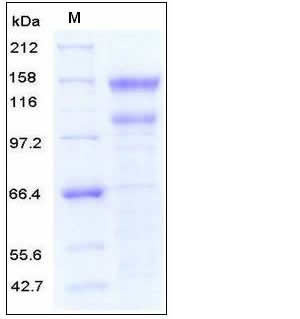Human LDLR / LDL Receptor Protein (His Tag)
FH,FHC,LDL R,LDL Receptor,LDLCQ2
- 100ug (NPP4055) Please inquiry
| Catalog Number | P10231-H08H |
|---|---|
| Organism Species | Human |
| Host | Human Cells |
| Synonyms | FH,FHC,LDL R,LDL Receptor,LDLCQ2 |
| Molecular Weight | The secreted recombinant human LDLR comprises 777 amino acids with a predicted molecular mass of 86 kDa. As a result of different glycosylation, it migarates with the apparent molecular mass of 110-140 kDa in SDS-PAGE under reducing conditions corresponding to the mature and immature form. |
| predicted N | Ala 22 |
| SDS-PAGE |  |
| Purity | > 85 % as determined by SDS-PAGE |
| Protein Construction | A DNA sequence encoding the extracellular domain of human LDLR (NP_000518.1) precursor (Met 1-Arg 788) was expressed with a C-terminal polyhistidine tag. |
| Bio-activity | Measure by its ability to bind with human PCSK9 in a functional ELISA . 1. Immobilized human PCSK9 at 10 μg/ml (100 μl/well) can bind biotinylated recombinant human LDLR . The EC50 of biotinylated human LDLR is 0.61 μg/ml. 2. Immobilized mouse PCSK9 at 10 μg/ml (100 μl/well) can bind biotinylated recombinant human LDLR . The EC50 of biotinylated human LDLR is 0.12 μg/ml . |
| Research Area | Cardiovascular |Lipids / Lipoproteins |Lipid Metabolism |Cholesterol Metabolism |
| Formulation | Lyophilized from sterile PBS, pH 7.4 1. Normally 5 % - 8 % trehalose and mannitol are added as protectants before lyophilization. Specific concentrations are included in the hardcopy of COA. |
| Background | LDL Receptor, also known as LDLR, is a mosaic protein which belongs to the Low density lipoprotein receptor gene family. The low density lipoprotein receptor (LDLR) gene family consists of cell surface proteins involved in receptor-mediated endocytosis of specific ligands. LDL Receptor consists of 840 amino acids (after removal of signal peptide) and mediates the endocytosis of cholesterol-rich LDL. Low density lipoprotein (LDL) is normally bound at the cell membrane and taken into the cell ending up in lysosomes where the protein is degraded and the cholesterol is made available for repression of microsomal enzyme 3-hydroxy-3-methylglutaryl coenzyme A (HMG CoA) reductase, the rate-limiting step in cholesterol synthesis. At the same time, a reciprocal stimulation of cholesterol ester synthesis takes place. LDL Receptor is a cell-surface receptor that recognizes the apoprotein B100 which is embedded in the phospholipid outer layer of LDL particles. The receptor also recognizes the apoE protein found in chylomicron remnants and VLDL remnants. |
| Reference |
